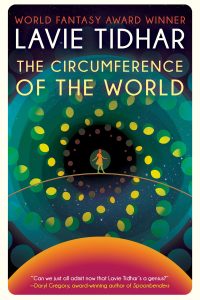Paul Di Filippo reviews Jean-Christophe Valtat
 Most book reviews—of fiction, anyhow—never mention book design or cover art. It’s just a sad fact that the hard work of graphic artists, so important from the consumer’s point of view in making a purchase decision and inspiring delight, invariably gets slighted. But when a book as handsome as Jean-Christophe Valtat’s Luminous Chaos appears, it offers us a good opportunity to remedy this common oversight.
Most book reviews—of fiction, anyhow—never mention book design or cover art. It’s just a sad fact that the hard work of graphic artists, so important from the consumer’s point of view in making a purchase decision and inspiring delight, invariably gets slighted. But when a book as handsome as Jean-Christophe Valtat’s Luminous Chaos appears, it offers us a good opportunity to remedy this common oversight.
This much-awaited sequel to Aurorarama eschews a dustjacket and prints its gorgeous cover art—stylish black silhouettes by Mahendra Singh, with red and yellow decorations—directly onto the boards, which feel thick, as if they have an extra dimensionality to them. Then comes a lovingly embellished title page, and many full-page illustrations by Singh throughout the text. All in all, a delightful package, and kudos to Melville House and everyone involved.
Now, on with the story!
The premise of Valtat’s steampunk cosmos is simple, yet rich: in the year 1907, in an alternate timeline, an exotic Arctic city named New Venice, established as “a dream answer to History’s nightmare,” exists as a kind of Oz-like refuge from the world’s cares. Not to say that New Venice does not possess all the urban problems and complexities of, say, Miéville’s New Crobuzon. Although Valtat’s tone and approach are infinitely more light-hearted and whimsical.
The first book saw the city through a rousing quasi-mystical revolution that restored the underage Siamese Twin Dauphin-Doges, Reginald and Geraldine Elphinstone, to power, under the regency of our hero, Brentford Orsini. But now, a year later, Orsini’s term of office is over, and into the Regent’s chair comes his archrival, the revisionist Peterswarden. Determined to exile Orsini and his six closest pals in a barely legal covert fashion, Peterswarden contrives a “diplomatic” mission to Paris. He dispatches the gang by a curious contrivance, the Psychomotive vehicle, piloted by one Colonel Branwell, who exists in a most odd and disembodied way. The trip starts out well enough, but then some Black Auroras send the craft astray, careening back in time to the year 1895. The Most Serene Seven (plus Branwell) eventually do end up in Paris. But is it the Paris of their own continuum, or a different one? And exactly what role does the mysterious Magnetic Crown play? And what of the deadly nationalists known as the Wolves of the Woods of Justice? Will the crew ever get home to New Venice, which doesn’t even exist in 1895? And if so, at what unimaginable price?
At first the reader is somewhat saddened and disconcerted by the swift departure from New Venice and its alluring culture. But then Valtat’s magnificent conception of 1895 uchronical Paris takes over, full of an equal amount of magic and mind-croggling weirdness. Séances, bureaucracies, conspiracies, debauched extravaganzas. Valtat evokes his twisted Symbolist-Decadent era to perfection, roping in some historical personages and also inventing a wealth of fictional oddballs. He is helped by having deftly established, back in the New Venice chapters, the unique characters of the Seven chums. (And, in a clever bit of parallelism, these introductions are matched with individual leave-takings at the climax.) While Orsini and his sidekick Gabriel maintain the forward momentum of the original mission, the others can engage, in alternating chapters, in their own illuminating exploits, several of which lead to mortal ends.
Valtat’s language is always stunning, baroque without being clotted. To realize that English is his second tongue is daunting to us mere monolinguists. His dialogue sparkles and the wry observations of his characters are very amusing. One wants to quote endlessly.
“Broken hearts are like beheaded chickens…They run furiously everywhere for a while, charging into nothingness, and once their blood is spent, they stumble miserably unto death.”
“In his opinion people usually—ridiculously—mistook onanism for a sexual practice and completely failed to understand that in its nature it was essentially mystical, a spiritual exercise—the melancholy shamanism of afternoon reveries. Beyond that, for a species dumb enough to have traded the penile bone for the opposable thumb, it had possibly been the key factor in the rise of imagination, not to mention the cornerstone of that most noble art known as Literature.”
If one could construct a school of writers similar to Valtat, one would have to ring in James Blaylock and Tim Powers, Walter Moers and Van Reid, and even Nick Harkaway and Thomas Pynchon. All these men have an ability not to take themselves too seriously, and yet to invest their comic creations with immense emotional and philosophical heft, conveying the deepest truths with the most outrageous and absurd characters and events. Long may these Ethical Surrealist Philosopher Jesters reign!








